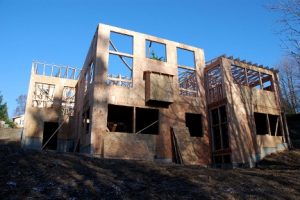Advanced Framing

Advanced Framing accomplishes two goals that go hand in hand. First, this method eliminates superfluous wall framing which saves on lumber costs. With the reduction of lumber, more insulation can be added which provides long term energy savings. Advanced Framing, or O.V.E (Optimal Value Engineering), is most effective when the home is designed specifically with this method in mind. Here is how it works:
- Floor plans are laid out in 24 inch grids with floor, wall, and roof framing lining up with this grid at a 24 inch spacing. When roof trusses correspond to wall studs, then a double top plate can be reduced to a single top plate.
- Window and door headers are reduced, eliminated, or resized to single width members such as a 2×10 rather than a 6×8. This conversion reduces wood, but more importantly, it provides the ability to add more insulation.
- Building corners, partition wall intersections, and door and window framing are simplified to provide for more insulation.
The common theme with advanced framing is the elimination of excess wood to prevent thermal bridging through the wall studs and increasing the amount of insulation. Wall studs only have an insulative value of R-7 compared with forms of insulation such as foam insulation or a combination of spray on foam with a cellulose insulation blanket which can reach as high as R-38 in a 2×6 cavity.
Other non conventional changes can be easily applied to most structures to greatly enhance their energy efficiency.
- Avoid placing plumbing (waste and supply lines as well as vents) in exterior walls as they degrade the ability to properly insulate the wall. Supply lines should come through the floor. Vents can often relocate to interior walls.
- Avoid placing electrical panels in exterior walls. They cause drafts and degrade the ability to properly insulate the wall. Place vertical wiring in interior walls whenever possible for the same reason.
- Use polyethylene plastic under "rat slabs" in the crawl space to significantly reduce moisture.
- Locate heat exchangers, furnaces, and ductwork within conditioned spaces due to the fact that they leak the conditioned air. Ductwork should never be placed in exterior walls because it prevents proper insulation and invites drafts.
- Locate clothes dryers as close to their exterior vent as possible for maximum efficiency.
- Increase the amount of attic insulation.
- Consider purchasing trusses that have a raised heel or designing them to cantilever to provide for more attic insulation over the exterior walls.


